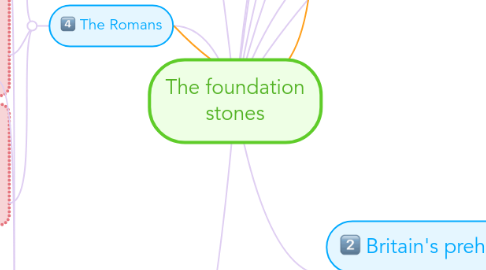
1. The Romans
1.1. The Romans brought th e skills of reading and writing to Britain.
1.1.1. The written word was important for spreading ideas and also for establishing power.
1.2. The Romans were determined to conquer the whole island .
1.2.1. The Romans considered the Celts as war-mad , "high spirited and quick for battle", a description some would still give the Scots, Irish and Welsh today.
1.2.1.1. The Romans could not conquer "Caledonia" , as they called Scotland, although they spent over a century trying to do so.
1.3. Roman control of Britain came to an end as the empire began to collapse.
2. The Celts
2.1. Around 700 BC, another group of people began to arrive, The Celts.
2.1.1. According to the Romans, the Celtic men wore shirts and breeches (knee-length trousers), and striped or checked cloaks fastened by a pin . It is possible that the Scottish tartan and dress developed from this "striped cloak".
2.2. The Cel ts were technically advanced.
2.3. They knew how to work with iron, and co uld make better weapons than the people who used bronze.
2.3.1. Their use of iron technology and their introduction of more advanced ploughing methods made it possible for them to farm heavier soils.
2.4. The Celts began to control all the lowland areas of Britain, and were joined bv new arriva ls from the European mainland.
2.5. The Celts are important in British history because they are the ance tors of many of the people in Highland Scotland. Wales, Ireland, and Cornwall today.
2.6. The British today are often described as Anglo-Saxon. It would he better to call them Anglo-Celt.
2.7. The Celts were organised into different tribes, and tribal chiefs were chosen from each family or tribe sometimes as the result of fighting matches between individuals, and sometimes bv election.
2.7.1. During the Celtic period women may have had more independence than they had again for hundreds of years.
3. Roman life
3.1. The most obvious characteristic of Roman Britain was its towns, which were the basis of Roman administration and civilisation.
3.2. Broadly, there were three different kinds of town in Roman Britain , two of which were towns established by Roman charter.
3.2.1. These were the coloniae, towns peopled by Roman settlers, and the municipia , large cities in which the whole population was given Roman citizenship.
3.2.2. The third kind, the civitas, included th e old Celtic tribal capitals, through which th e Romans administered the Celtic population in the countryside.
3.3. Outside the towns, the biggest change during the Roman occupation was the growth of large farms, called "villas".
3.3.1. These belonged to the richer Britons who were, like the townspeople, more Roman than Celt in their manners.
3.4. In some ways life in Roman Britain seems very civilised. but it was also hard for all except the richest.
4. Britain has always had the most political power.
5. The southeast Britain has always been the most populated part of the island.
6. At moments of great danger Britain has been saved from danger by its surrounding seas.
7. South and east on the hole have better agricultural conditions.
8. Climate affects social and economical life in every country.
9. The island
10. Britain's prehistory
10.1. Britains has not always been an island.
10.1.1. It became one only after the end of the last ice age.
10.2. Our first evidence of human life is a few stone tools. (About 250,000 BC.)
10.2.1. These simple objects show that there were two different kinds of inhabitant.
10.2.1.1. The earlier group made their tools from flakes or flint, similar in kind of stone tools found across the north European plain as far as Russia.
10.2.1.2. The other group made tools from a central core or flint, probably the earliest method of human tool making.
10.3. Around 50,000 BC. a new type of human being seems to have arrived, who was the ancestror of the modern British.
10.4. Around 10,000 BC, as the Ice Age drew to a close, Britain was peopled by small groups of hunters, gatherers and fishers.
10.4.1. Few has settled homes and they seemed to have followed herds of deer which provided them with food and clothing.
10.5. By about 5000 BC Britaind had finally become an island, and had also become heavily forested.
10.6. About 3000 BC Neolithic (or New Stone Age ) peopl e crossed th e narrow sea from Europe in small round boats of bent wood covered with animal skins.
10.6.1. Each could carry one or two persons.
10.6.2. These people kept animals and grew corn crops, and knew how to make pottery,

